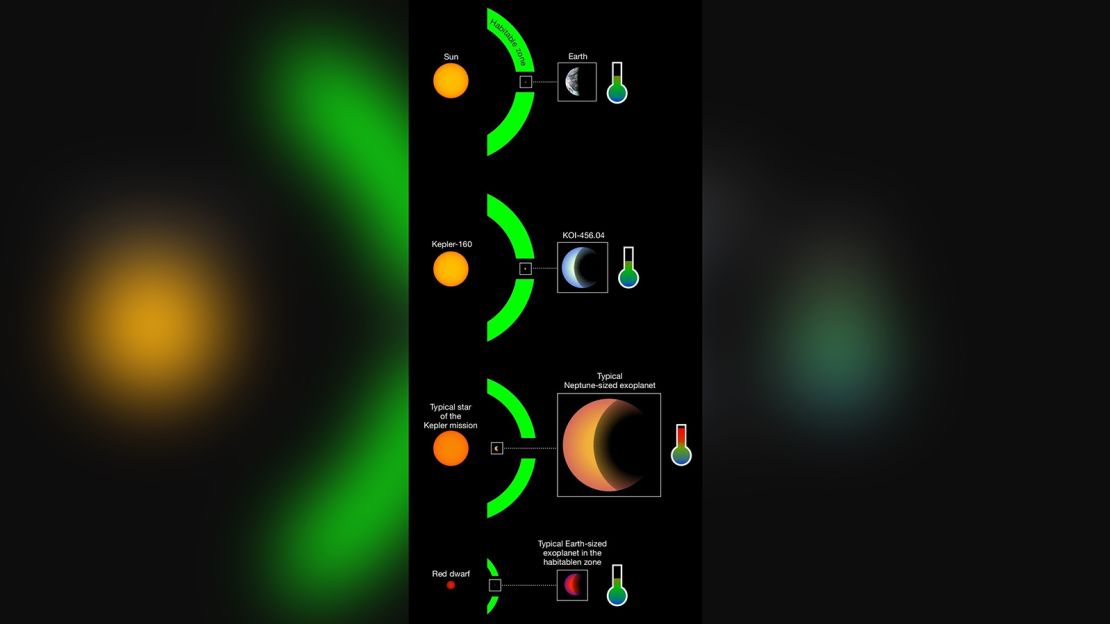Key Takeaways:
- Scientists found evidence for 2 additional planets orbiting a sun-like star (Kepler-160) using data from NASA’s Kepler mission.
- One of the newly discovered planets (Kepler-160d) is likely too hot for life due to its close proximity to the star.
- The other potential planet (KOI-456.04) is less than twice Earth’s size and within the habitable zone of its sun-like star, meaning it could potentially support liquid water on its surface.
- This potential planet’s orbital period around its star is similar to Earth’s year (378 days).
- While promising, KOI-456.04 still needs confirmation with further observations as there’s an uncertainty of it being a planet.
It’s estimated that scientists have discovered an Earth-sized exoplanet circling a sun-like star some 3,000 light years from Earth.
The star, designated Kepler-160, was detected between 2009 and 2013 as part of NASA’s exoplanet-hunting Kepler mission. It is comparable to our sun in both size and temperature.
It has been discovered through earlier observations conducted over the past six years that Kepler-160b and Kepler-160c are the two exoplanets orbiting Kepler-160. However, because they orbit the star so closely and are much larger than Earth, their surfaces are extremely hot and uninhabitable by life.
Little variations in the time it takes Kepler-160c to orbit the star suggested, however, that there might be a third planet in the system. Rather, two more planets were discovered by astronomers.
René Heller, the lead study author and scientist at the Max Planck Institute for Solar System Research, said in a statement that “our analysis suggests that Kepler-160 is orbited not by two but by a total of four planets.”
The journal Astronomy & Astrophysics published a study that details their findings.
Kepler-160d, the third planet, is the cause of Kepler-160c’s orbital distortion. Even more intriguing and unique is the other possible planet they found.

The candidate planet is known as KOI-456.04. Its sun-like star provides it with light of a similar kind and quantity, despite being less than twice the size of Earth.
Additionally, because of its orbital distance, the planet candidate is inside the star’s habitable zone, where its surface temperature may allow for the support of liquid water and the possibility of life. That is comparable to Earth’s position with respect to the sun.
Additionally, its orbital period around the star is 378 days, which is comparable to how long it takes an Earthling to complete one orbit around the sun.
When compared to many other planets that are thought to be potentially habitable, KOI-456.01 is comparatively large. However, what makes it so unique and recognizable is the combination of its solar-type host star and its planet, which is less than twice the size of Earth, according to Heller.
Conditions on the surface of this possible planet may be similar to Earth due to the way it interacts with its host star, but this is dependent on whether or not it has an atmosphere. According to the researchers, the average temperature of the planet would be comparable to the mean global temperature of Earth if it had a stable atmosphere and mild warming caused by a greenhouse effect.
Finding exoplanets
Using a detailed model of variations in star brightness, the researchers searched through Kepler data and found the two additional potential planets in the Kepler-160 system. By sifting through the archival data gathered during the nine-year Kepler mission, they have discovered 18 exoplanets thus far.
“The planetary signal is so faint that it’s almost entirely hidden in the noise of the data. In the crucial cases, our new search mask performs marginally better in distinguishing a genuine exoplanetary signal from the noise, according to Heller.
Though they haven’t ruled out the possibility that this is a measurement error, the researchers issued a warning, saying that they haven’t verified that this is a planet. Their data indicates that it has an 85% chance of being a planet, but a 99% chance is needed to qualify as a planet.
Future observations of the system using ground or space-based telescopes could confirm if it’s a planet. Among other things, the PLATO mission of the European Space Agency will look for planets the size of Earth orbiting sun-like stars when it launches in 2026.
Instead of circling sun-like stars, a large number of Earth-sized exoplanets have been found orbiting small red dwarf stars in recent years. Since the exoplanets orbit these stars are closer than Earth is to the sun, despite the fact that these stars are much smaller and colder than our sun, it is likely that their moderate surface temperatures are similar.
Unlike the visible light that the sun emits, these red dwarf stars release infrared radiation. They also lash their planets with highly energetic flares and radiation, which is why these planets are debated as potential hubs for life outside of our solar system.
“The full picture of habitability, however, involves a look at the qualities of the star, too,” Heller said.


